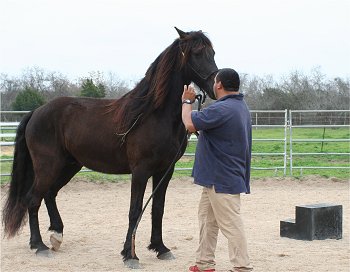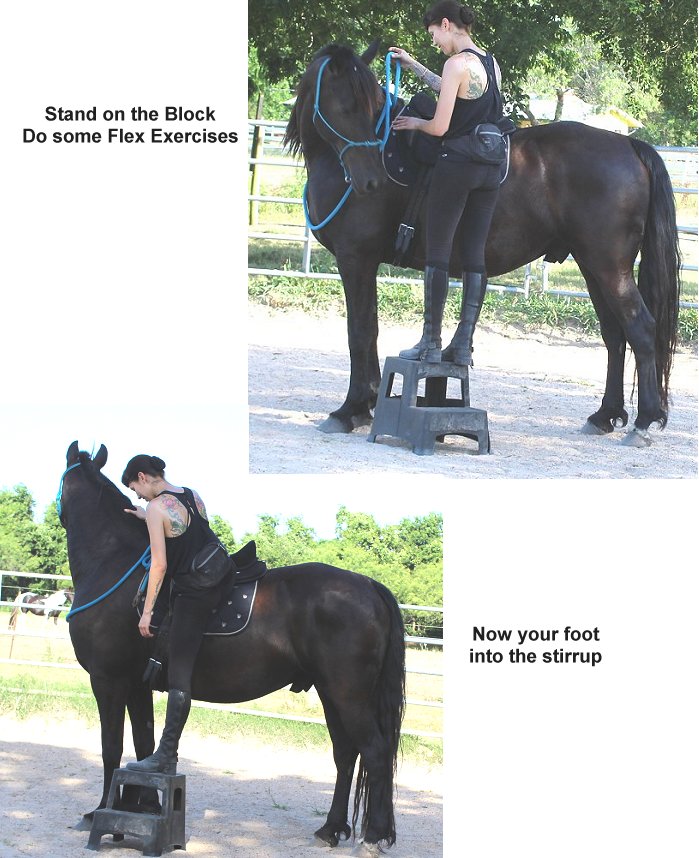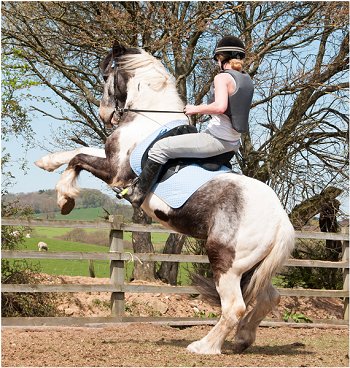 Every horse should be as easy to mount as this one. A horse that won’t stand still while you mount is, to say the least, irritating and even dangerous.
Every horse should be as easy to mount as this one. A horse that won’t stand still while you mount is, to say the least, irritating and even dangerous.
If you’re lucky, you mount and dismount your horse from the ground. If you’re older (like I am) or your horse is particularly tall (like the Friesian crosses I train) you need a mounting block. Either way, the horse must stand still until you are safely in the saddle and ready to move off.
A Horse Who Walks off Before You are Ready
The easiest mounting problem to solve is a horse who walks off when you are half way mounted. This type of horse has unwittingly been trained to walk off by an owner who doesn’t understand ANTICIPATION.
Remember that horses are creatures of habit and that they learn the steps of a maneuver by repeating them in order like a dance. We use anticipation to our advantage in most cases. If a horse has done step 1, then step 2, then step 3, then step 4 (in order) frequently enough, he will reduce it to step 1 then step 4 in a short time, saving himself time and energy by eliminating steps 2 and 3.
This works to our advantage in such exercises as moving forward on your request. Step 1 is squeeze your legs together. Step 2 is Kiss, Step 3 is spank with the reins. We want the horse to anticipate steps 2 and 3: move forward with just a slight squeeze of the legs.
Mounting also has steps.
If you put your foot into the stirrup, bring your body up to the saddle, sit astride and then immediately move away from the mounting block,
he will understand those 4 steps. Soon the steps will be reduced to “Put your foot into the stirrup. Walk away.”Why wait for the middle two steps? The goal is to walk away. Get to it.”
In order to stop this problem, you must interrupt the goal. Make step 4 of your mounting procedure a static exercise – one that goes nowhere.
After mounting, stand. Stand some more. Stand longer still. Even better, stand and ask for repeated lateral flex exercises. The exercise of bringing your horse’s head around to your boot on each side quickly and lightly is the perfect interruptor. It is done in place. And it reinforces a light mouth and general respect of his rider. Read more about lateral flex.
A horse Who is Afraid of the Mounting Block
 A horse who is not de-sensitized to the mounting block needs more experience with it as an object in his environment. Introduce it early. Your ultimate goal is to make the horse oblivious to the block. You should be able to approach with it in hand and drop it loudly anywhere in his space. He should even tolerate it being tossed under his belly to the other side. He should stand calmly while you climb its steps.
A horse who is not de-sensitized to the mounting block needs more experience with it as an object in his environment. Introduce it early. Your ultimate goal is to make the horse oblivious to the block. You should be able to approach with it in hand and drop it loudly anywhere in his space. He should even tolerate it being tossed under his belly to the other side. He should stand calmly while you climb its steps.
Your tacked horse should be awaiting your mount wearing his halter and lead, mounting block nearby. Pick up the block and drop it into position. If he moves, use the block as a desensitizing tool. Hold his rope in one hand and the mounting block in the other. Begin dropping the block further from his body until you find his tolerance distance: the distance at which he does not move away from the block. Drop it there several times.
Baby Step #1: Now begin dropping it closer and closer. When he gets nervous, stop, hear his concern, let him rest. When he has had a moment to think, you can pick it up and drop it in the same place again. If that is fine, move inches closer. If he actually wigs out and begins to travel backward, follow his retreat (you will be actually holding the mounting block in your hand as you follow him) until he stands still. Then let him rest. When he shows you signs of being calm again, drop the box again a little further than is “wig out” distance and work closer again. Repeat this until he realizes that standing still stops the activity.
Now, baby step #2 – stand on the block and practice some flexing exercises, then step down without mounting at all.
Baby Step #3: Stand on the block and put your hand in the stirrup. Put a little weight into the stirrup so he feels it pull down.
Baby Step #4: When this is routinely accomplished without a problem, put your foot into the stirrup. If he moves away or walks off, get down, reposition him, and try again.
When accomplished, mount and SIT. Ask for some flexes both left and right. Then dismount. Do this several times until he realizes that mounting is not unpleasant, and it is not always followed by moving off.
Make it a routine from now on that each mount is followed by 60 seconds of standing and/or flexing before any take-off is requested.
A horse who prevents mounting by moving away or doing dangerous things is a real problem.
First, let’s preface this discussion with a couple of assumptions:
1. You are not plopping yourself into the saddle seat with a painful bounce
2. You are sure that he does not have any pain or back issues that have caused him to be shy of mounting
A Horse Who Swings Away From the Block
A horse who refuses to let you mount by moving away from the mounting block as your foot is raised to the stirrup is usually a horse who lacks respect for his rider. If he gets away with moving away from the mounting block or whirling away from you as you lift your leg, he wins the game.
Usually it is his rear that moves away from the block. Study at what point he moves: Is it when you start to mount the block? Is it when you make the approach to the stirrup?
If you have tried repeatedly re-positioning him and he persists in moving away when you make the motions to mount, he must be given an outcome that is more objectionable than letting you mount calmly. There must be negative repercussions for his bad behavior. For this type of horse, the quick-fix rear-disengage exercise works wonders:
Step #1: Your tacked horse should be awaiting you at the block wearing his halter and lead. Drape your lead over your left arm and start up the steps. If he moves away, whirls or backs away, pop back to the ground and get after his rear with the rope, spinning his rear around and around and around and around. Move his rear feet fast and furious for a couple of full circles. Let up the pressure and get back to the proper position at the block. Let him stand a few seconds to contemplate how pleasant standing still next to the block can be, then start climbing the steps again. If he moves away again, repeat the rear disengage procedure.
Do the same thing at whatever moment he moves away. If it is when you approach the stirrup, get down and after him again.
 Repeat until he stands still for your approach to the stirrup. Don’t mount yet.
Repeat until he stands still for your approach to the stirrup. Don’t mount yet.
Step #2: – Stand on the block and practice some flexing exercises, then step down without mounting at all.
Step #3: When this is routinely accomplished without a problem, put your foot into the stirrup. If he moves away or walks off, repeat the steps above until he stands for this operation.
When accomplished, mount and SIT. Ask for some flexes both left and right. Then dismount. Do this several times until he realizes that mounting is not unpleasant, and it is not always followed by moving off.
Make it a routine from now on that each mount is followed by 60 seconds of standing and/or flexing before any take-off is requested.
A Horse Who Actually gets Dangerous at the Mount
 There is no short cut for a horse who refuses to let you mount by whirling furiously, bucking, running, rearing or worse. He is the most dangerous horse. This horse MUST GO BACK TO THE BEGINNING OF RESPECT. Go back to ground exercises, starting with longing at every gait in every direction. Forcefully make him capitulate to your demand that he move when you tell him to move. Become the head-mare in your pasture. “Move left when I tell you. Move right when I tell you. Pick up your feet and move fast when I tell you.” Most people have no idea how much they can expect from their horse. This type of horse is a great companion when you are a leader. But he is a dismal friend when HE is the leader. In fact, this type of horse generally has many other objectionable and even dangerous behaviors that should be cured even before tackling the mounting issue. Read more about longing and on-line longing.
There is no short cut for a horse who refuses to let you mount by whirling furiously, bucking, running, rearing or worse. He is the most dangerous horse. This horse MUST GO BACK TO THE BEGINNING OF RESPECT. Go back to ground exercises, starting with longing at every gait in every direction. Forcefully make him capitulate to your demand that he move when you tell him to move. Become the head-mare in your pasture. “Move left when I tell you. Move right when I tell you. Pick up your feet and move fast when I tell you.” Most people have no idea how much they can expect from their horse. This type of horse is a great companion when you are a leader. But he is a dismal friend when HE is the leader. In fact, this type of horse generally has many other objectionable and even dangerous behaviors that should be cured even before tackling the mounting issue. Read more about longing and on-line longing.
Here is a Clinton Anderson video showing one of these horses in action and the “cure”. Obviously this is an ad for Clinton Anderson training (which I like in most instances), but you can fast forward through those parts and get to the meat of the issue. I will present videos from many natural horsemanship trainers throughout the “Horse Problems” section where they are instructional and appropriate.
Horse training and equestrian activities in general can be dangerous. While we try to present relevant and valuable content, under no circumstances does horse-pros.com or its members or contributors take any responsibility for the well-being of any horse or person using a method outlined here.
We certainly don’t know everything. Please share your expertise and experiences. Comment on what is already written or Suggest a Category and Educate us about it. Grow Horse-Pros.com©
